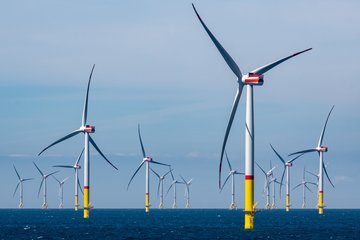Symbiosis in ancient corals
Analysis of nitrogen isotopes provides evidence of the earliest known photosymbiosis in corals of the Devonian
A research team led by researchers from the Max Planck Institute for Chemistry in Mainz has used nitrogen isotope analysis to demonstrate that 385 million years old corals of the Devonian from the Eifel and Sauerland regions had symbionts. This finding represents the earliest evidence of photosymbiosis in corals. Photosymbiosis might explain why ancient coral reefs grew to massive sizes despite being in nutrient-poor environments.

Coral reefs rank among the most biodiverse habitats on Earth and are often referred to as the rainforests of the sea. Modern reef building corals evolved in the Triassic Period around 250 million years ago. They can live in symbiosis with tiny organisms, often algae, that can carry out photosynthesis. This photosymbiosis is particularly beneficial in nutrient-poor waters because it helps the corals to recycle scarce nutrients.
Geological evidence reveals that corals already existed in the Devonian period, over 385 million years ago, for example in the Eifel and Sauerland regions in Germany. Fossilized corals of the extinct orders Tabulata ("honeycomb corals") and Rugosa ("horn corals ") found in these regions indicate that the Rhenish Massif was once covered by a tropical sea during the Middle Devonian period, where huge reefs thrived. However, it is not clear whether the extinct groups of corals of the Devonian had photosymbionts or not.
A research team led by researchers from the Max Planck Institute for Chemistry, the Goethe University Frankfurt, and the Senckenberg Research Institute and Natural History Museum Frankfurt has now demonstrated, using nitrogen isotope analyses, that some extinct corals from the Middle Devonian period were already symbiotic. This represents geochemical evidence of the oldest confirmed photosymbiosis in corals.
Comparison of symbiotic and non-symbiotic corals
The researchers were able to demonstrate the symbiosis by comparing nitrogen isotope values in the organic material of today's symbiotic and of non-symbiotic corals. Nitrogen isotope values, specifically the ratio of "heavy" nitrogen (15N) to "light" nitrogen (14N), are suitable for differentiating between different stages of the food pyramid. For example, researchers can analyze the nitrogen isotopes to determine whether a living organism had a vegetarian or meat-based diet. The higher an organism is in the food pyramid, the higher its nitrogen isotope value. This is because organisms metabolize lighter nitrogen more quickly than heavier nitrogen, leading to easier excretion of the lighter isotope.
Analyzing modern corals revealed a consistent difference: corals that obtain their energy primarily from the photosynthesis of symbiotic algae have lower nitrogen isotope values. In contrast, corals that feed themselves by actively catching plankton have nitrogen isotope values that are higher.
Jonathan Jung from the Max Planck Institute for Chemistry says: "The constant difference in nitrogen isotope values is in line with our expectations and shows the typical jump in the food chain. This is because symbiotic corals are one level below non-symbiotic corals in this hierarchy." The marine geochemist Jung is first author of the study now published in the journal Nature.
Fossil samples from the Sauerland, Eifel, Western Sahara and Morocco

Co-author and co-initiator Simon Felix Zoppe from the Goethe University Frankfurt states: “On the basis of this knowledge, we were able to investigate which niche the corals occupied in the Devonian." To this end, the researchers analyzed freshly collected fossil corals from the Sauerland, and museum specimens from the Eifel, the Western Sahara and Morocco from the collection of the Senckenberg Research Institute and Natural History Museum Frankfurt.
The difficulty lies in the fact that, in fossils, the proportion of organic material required for analysis is extremely low. However, a team led by Alfredo Martínez-García from the Max Planck Institute laboratory used a novel analytical method that that only requires a few milligrams of finely ground fossil coral material.
The fossils also revealed a consistent difference in nitrogen isotope values among individual coral species. Typically, the colony-forming corals of the order Tabulata and Rugosa showed significantly lower nitrogen isotope values than the mostly solitary corals of the order Rugosa. This led the scientists to conclude that certain coral species were already living in photosymbiosis during the Middle Devonian period. "Photosymbiosis could explain why ancient reefs were highly productive and enormous in size despite the nutrient-poor environment," says Alfredo Martínez-García.
The study serves as the start for a more detailed investigation into the nutrient cycle of the Paleozoic era, which includes the Devonian. The method aids in understanding the extent to which the mass extinction of corals and other reef inhabitants towards the end of the Devonian period is connected to ocean nutrient levels. "Moreover, this new insight allows for a better understanding of the food chains of early reefs," adds Eberhard Schindler from the Senckenberg Research Institute and Natural History Museum Frankfurt. This could, in turn, offer valuable insights for contemporary coral ecosystems. Additionally, the researchers aspire to extend their research further into the geological past.
Devonian
The Devonian is a geological period of the Paleozoic Era. It began around 419 million years ago and ended around 359 million years ago. During the Devonian, the tectonic plates on Earth were very active and the Laurussia and Gondwana supercontinents moved closer towards each other together. Huge coral reefs formed in the Middle Devonian, many of which are preserved as fossilized structures in present-day Europe, North America, North Africa, Australia, Siberia and China.
Nitrogen isotope analysis
The higher the ratio of the nitrogen isotopes 15N to 14N in a sample, the higher the animal's position in the food chain. Animal metabolism generates nitrogenous waste products like ammonium or urea. The excretion of these metabolic products results in an increased ratio of "heavy" nitrogen (15N) to "light" nitrogen (14N) in the organism compared to its food. Consequently, corals that feed on plankton exhibit a higher nitrogen ratio than symbiotic corals.













